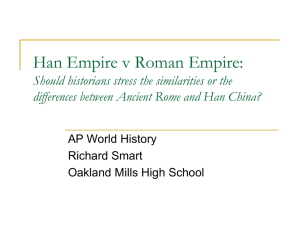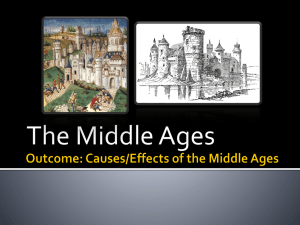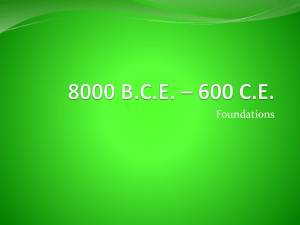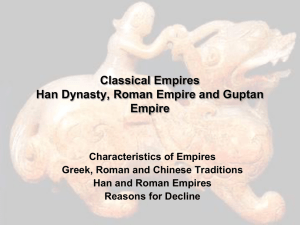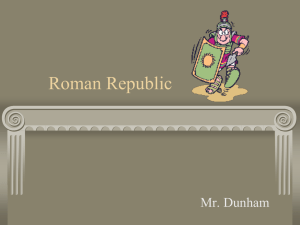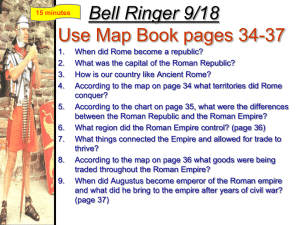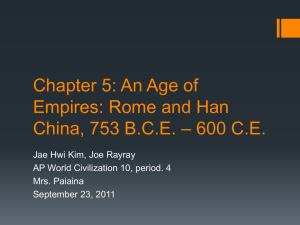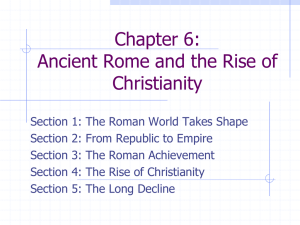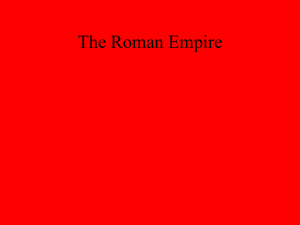Roman Empire-Christianity
advertisement
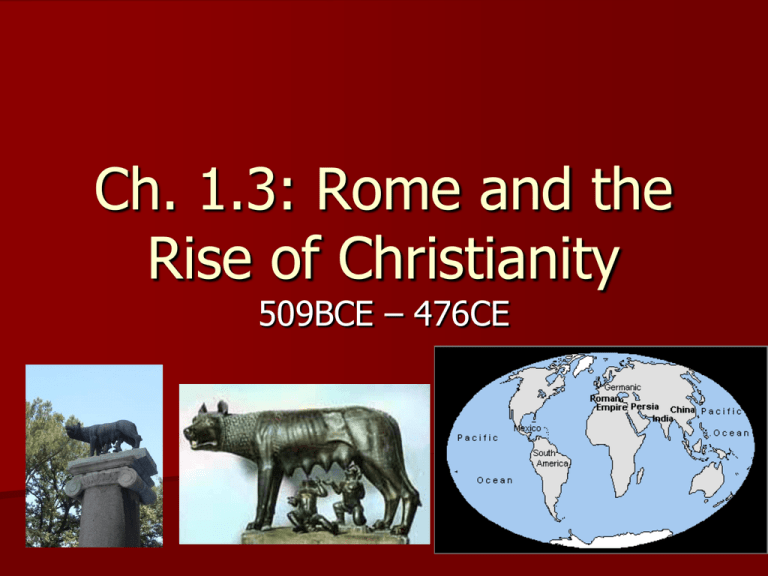
Ch. 1.3: Rome and the Rise of Christianity 509BCE – 476CE I. The Roman State A. 1. 2. While Greece is in decline, Rome is developing power Began as a monarchy, but by 509BCE overthrown by the aristocracy, who created a republic (power is held by citizens who elect leaders to make decisions – representative democracy) 2 Groups competed for power: – Patricians: aristocratic landowners, held the most power – Plebeians: farmers, artisans, merchants; sought (and eventually gained) power Senators Patricians Military Tunics Plebs A. Roman Government 1. 2. 3. Roman gov. set up w/ separate branches Executive: 2 consuls, chosen annually, headed army and ran gov. Legislative: Senate and 2 assemblies – – Senate made up of 300 landowners Made foreign policy, economic policy and advised consuls Assemblies – Council of Plebs, created 471BCE to protect plebeians Tribunes were elected by & protected the rights of the plebs. Senators were chosen for life. They protected the Treasury & made laws. B. Roman Law 1. 2. The Twelve Tables were hung in the Roman Forum. Twelve Tables, 451BCE: First written code of laws At first, civil laws only applied to Roman citizens, but as Rome expanded and brought conquered people under its rule had to create a universal system of laws, Law of Nations – – Based on reason and justice, applied to all peoples, protect citizens and property Principles: all citizens have equal protection under the law Innocent until proven guilty The burden of proof rests w/ the accuser Unfair laws repealed C. Code of Justinian 1. By 528CE, Emperor Justinian compiled all laws throughout the Empire into 4 books: – – – – 2. The The The The Code (500 laws) Digest (legal opinions) Novellae (new laws added after 534CE) Institutes (law textbook) Created a government of laws, not of men Justinian I & Empress Theodora Byzantine Rulers, 527-565CE Mosaic, San Vitale Cathedral, Ravenna, Italy, ca. 547. II. The Influence of the Roman Empire A. Roman republic lasted 5 centuries, but by 1st Century became an Empire – Expansion of empire too large for a republic to control 1. 2. Augustus (formerly Caesar Octavian) began the Roman Empire in 27BCE Pax Romana, period of peace and prosperity beginning under Augustus & lasting from 14-180CE. Augustus, 1st C., Roman marble copy of bronze statue, Vatican Museum. Roman language, law, architecture, and engineering spread throughout Empire Roman Empire ca. 116CE at its largest extent Roman Architecture: The Colosseum, 72 – 80CE III. The Development of Christianity A. 1. 2. 3. 4. 5. The birth & expansion of Christianity occurred in the Roman Empire. Empire spread to Judaea (Palestine) by 6CE Jesus (ca. 6BCE-29CE), a Jewish prophet, preached simple message & told followers he did not want to destroy traditional religion Transformation of inner person most important, not strict following of laws Taught to love God and one another Ethical ideas: humility, charity, brotherly love Supper at Emmaus, Caravaggio 1601, The National Gallery, London. 6. 7. 8. 9. Conservatives believed he was undermining respect for traditional Judaism Romans believed he was a potential revolutionary Given up by opponents to Pontius Pilate, the Roman procurator, who ordered death by crucifixion Loyal followers spread story of his resurrection and proclaimed him the Messiah Pilate, Giotto, 1305, fresco, Arena Chapel, Padua. Flagellation, Caravaggio, 1607, Naples. The Passion in Western Art Entry into Jerusalem, Duccio, 1311, panel, Siena (Early Renaissance). Christ Washing the Disciples Feet, Tintoretto, 1547, Oil, Prado Museum, Madrid (Renaissance). The Denial of Peter, The Last Supper, Dali, 1955, Oil, National Gallery, Washington, D.C. (Surrealism) Rembrandt, 1660, Oil, Rijksmuseum, Amsterdam. (Baroque) The Taking of Christ, Caravaggio, 1602, Oil, National Gallery, Dublin (Baroque). Christ Before Pilate, Pontormo, 1525, fresco, Florence. The Flagellation, della Francesca, 1460, tempera, Urbino. Deposition, Van der Weyden, 1440, Prado Museum, Madrid. Christ Carrying the Cross, El Greco, 1580, the Met, New York. Pieta, Michelangelo, 1499, marble sculpture, St. Peter’s Basilica, Vatican City. Lamentation, Giotto, 1305, Arena Chapel, Padua. Entombment, Raphael, 1507, Galleria Borghese, Rome. Resurrection, Bellini, 1479, Berlin. Ascension of Christ, Perugino, 1498, Lyon. The Incredulity of St. Thomas, Caravaggio, 1602, Potsdam. B. Christian Persecution & Final Triumph Early Christianity viewed as small sect w/in Judaism Christians persecuted under Emperor Nero (5468CE) after the “great Roman fire” of 64CE – Refused to honor Roman gods & emperor Grew slowly anyway & spread widely by 3rd Century Crucifixion of St. Peter, Caravaggio, 1600, Sta. Maria del Popolo, Rome. C. Spread of Christianity 1. Personal faith open to all – All social classes welcome: women, slaves, rich, poor had “spiritual equality” Promise of salvation 3. Familiar & easy to understand (Christ was human) 4. Formation of communities, sense of belonging 2. 5. 6. 7. 313CE Constantine became 1st Christian emperor & proclaimed Edict of Milan, official tolerance of Christianity Under Theodosius the Great (378-395CE), Christianity became official religion of the Roman Empire, all others illegal Throughout Middle Ages, Roman Catholic Church dominated both religious & political life St. Ambrose forbids Theodosius from Entering the Church, Van Dyck, 1619, National Gallery, London. The Pantheon, 125 – 28CE Arch of Constantine, 312-315CE

